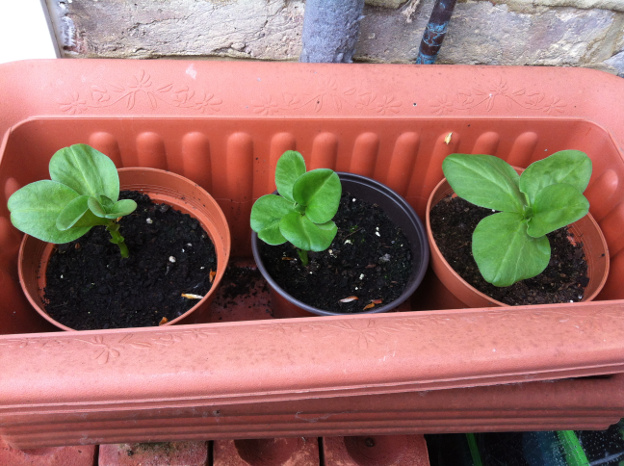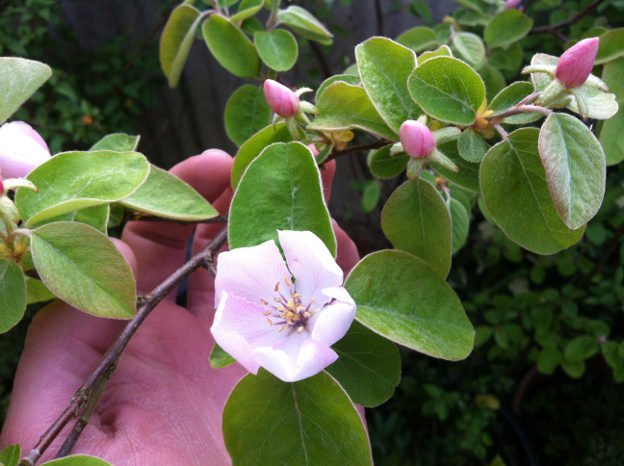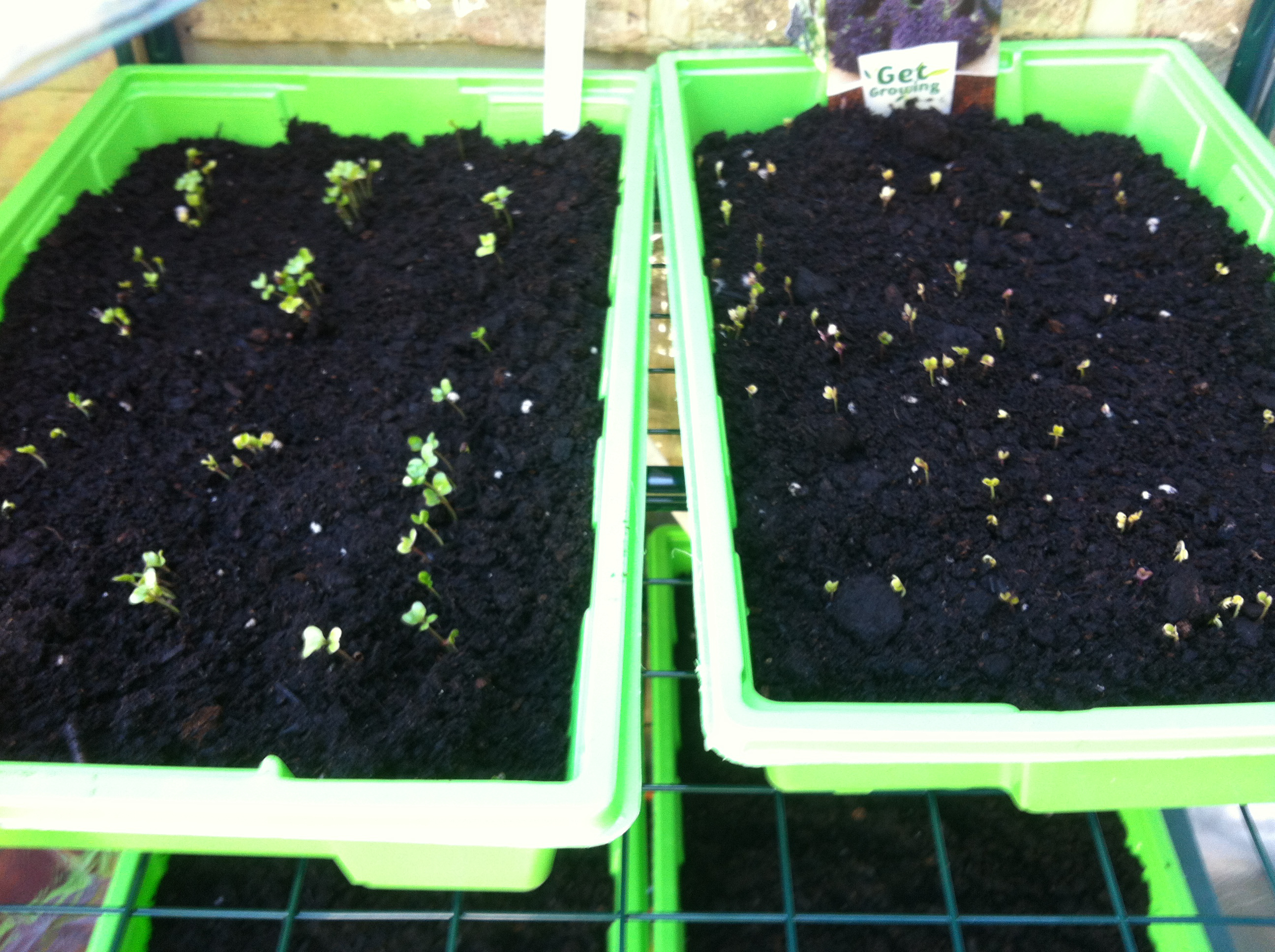Spring has well and truly sprung here in the East of England. We’re surrounded by beautiful blossom in our garden. We’ve also been busy planning this year’s crops, preparing beds and sowing seeds. It’s strange to think that we’ve been in this house for a year now. This time last year we were just sowing the first of our seeds – a very late start due to the move. Despite this we still had a very successful growing season. This year we’re better placed as we’ve started earlier – so we’re hoping for another bumper harvest.
The many plum trees in the garden are covered in blossom, as is our cherry tree, our apple trees and our quince and medlar trees. I say the apple trees are, but there is one exception. Our Court Pendu Plat apple tree. This is an ancient variety of apple. Some sources suggest it may date back to Ancient Rome. It was certainly in common cultivation in the seventeenth century, when it was known as ‘the wise apple’, because it blossoms so late in the season that it never loses its blossom to late frosts. This is our only fruit tree that is yet to blossom this year.
Our plans for the garden are to follow a four-crop rotation plan. This means that the pumpkin patch will not be home to squashes, pumpkins and courgettes this year. Which we are quite sad about. Just last week we ate the last of last year’s squashes (the Turk’s Turban). That small patch of land gave us so much. We had courgettes pretty much every day throughout the whole summer and enough squashes to last us all winter. Unfortunately we’ll not be growing quite so many squashes this year, as our miscellaneous bed will be smaller than the pumpkin patch.
We’ve decided to follow the crop rotation plan from Dick and James Strawbridges’ Practical Self-Sufficiency book. According to this the pumpkin patch is now going to become a bed for our root crops, that is alliums and umbellifers (onion and carrot families). However, the soil here is full of stones. We don’t mind forked crops, but we’d like to avoid them if possible. So I’m having to dig and sieve, which is quite time consuming.
In the crop rotation plan in the book, one of the suggestions in the root crops section is quinoa. This intrigued us. We’ve never grown it before, but we’ve now sourced some seeds, which have germinated in a seed tray. We’re quite excited about growing quinoa. Plus it has the benefit of being grown with the root crops, but not being a root crop, so I won’t need to dig and sieve the section we’re setting aside for it.
We’ve got seedlings everywhere at the moment. It’s always chaos at this time of year, everything needs to be germinated, but it’s too early to plant them out. Fortunately it’s warmed up sufficiently to make us quite confident that there won’t be any more frosts, so we’re hardening our seedlings off now with a view to start planting them out next weekend.
Some other exciting crops we’re trying this year include a centuries old variety of bean – the Martock field bean. Field beans are the ancestors of the broad bean. This variety of the bean hails from the village of Martock in Somerset, where it has been grown for centuries. There is a paragraph on them in Sue Stickland’s Back Garden Seed Saving book, and they also grew them on the farm in the BBC’s excellent living history series Tales From the Green Valley, where they ran a farm as it would have been run in the seventeenth century. They are a crop that’s been on our radar for some years, and now we are now looking forward to trying them.

Young Martock field bean plants. We have three rows of these in the big vegetable patch. These potted plants are in reserve to replace any we lose to slugs.
They are apparently like broad beans, only smaller. Traditionally they would have been dried and eaten over the winter in stews, gruels and the like. When they are in season there are so many other crops available with poorer keeping qualities, that historically it didn’t make sense to eat them fresh. Dried they would last all winter and into the spring, when there would be much less edible vegetation.
This historic system of drying legumes for winter and spring consumption is something that has always interested us. In the summer, autumn and early winter we often get a real glut of crops from the garden. But from January until about May there’s very little to be consumed from the garden. We’ve always enjoyed making our preserves and drying our pea beans to extend our harvest, but this year we’re planning to dry some of the Martock field beans and also some peas to use over the winter, as our ancestors did.
We found a variety of pea that sounded perfect for this role, a variety named Boddington’s Soup Pea. Apparently they are too starchy to be enjoyable eaten fresh, but when dried and rehydrated they make an excellent soup. They can also be used in stews, curries and I dare say they would make a fine gruel. So our plan is to dry the entirety of this crop and use it over ‘the hungry gap’ of those months when the garden is at its least productive.
Another new crop we plan to grow for the first time this year is oca. Oca are potato-like tubers originating from South America. They are smaller than potatoes, apparently with a hint of lemon to their flavour. We’ve never eaten one, but we’re excited to do so. Although they are like potatoes, they are not related to potatoes and they are not affected by blight. In theory we should be able to save some tubers from this year’s harvest to grow next year, enabling us to become (slightly) more self-sufficient.
We really are very excited about these ocas. They apparently give high yields from small spaces. From a culinary point of view they appear to be quite versatile. Like potatoes they can be baked, boiled or steamed. But there are other options too – I’ve read that they can be eaten raw and have a sweet and tart flavour, plus the leaves are edible. The tubers also keep well for several months. If ocas live up to our expectations I can see them becoming a big part of our garden in future years.
We have several new varieties of tomato and chilli that we are growing this year. We’re also determined to get a decent yield of brassicas this year, after last year was quite disappointing. There are some other interesting crops that we haven’t sowed yet, but I’m weary of the fact that this post is already quite long. I’ll post more details as the season progresses. Please post in the comments below if you have any tips or questions about any of the new crops we are trying. We’d particularly like to hear from you if you’ve grown ocas. Are they as good as they appear to be?





